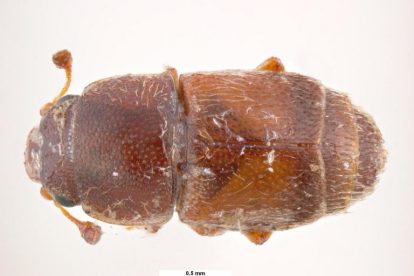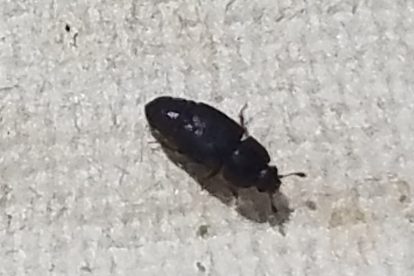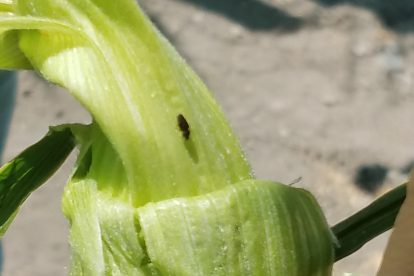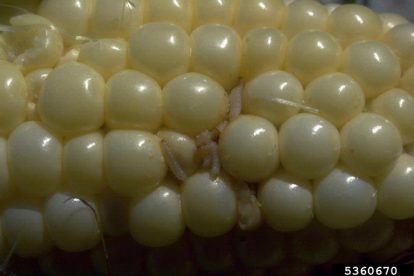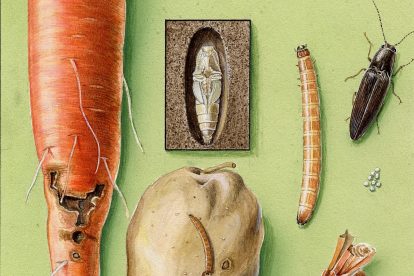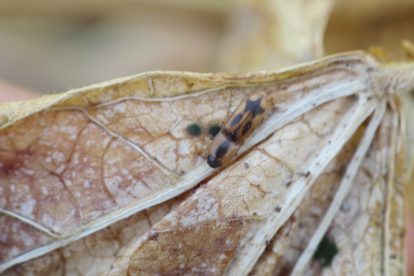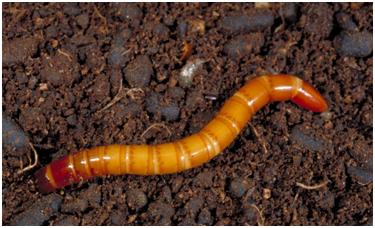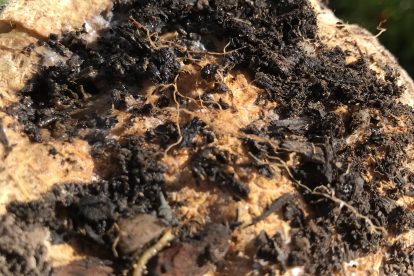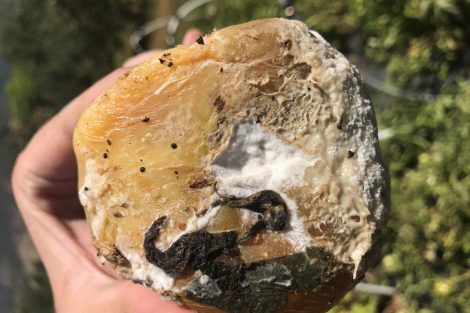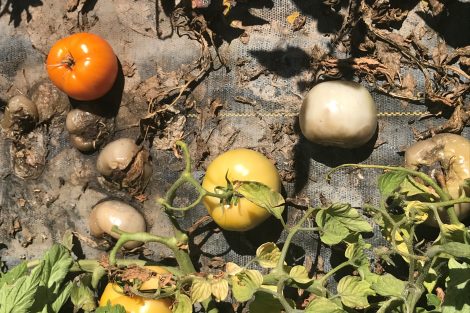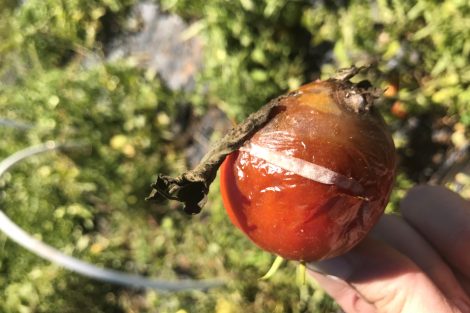Sap Beetles
Sap Beetles are present now, notably in fields and gardens with overripe or damaged crops. Especially melons, sweet corn, tomatoes, and occasionally other vegetables. In Utah, common, common species include the Corn Sap Beetle (Carpophilus dimidatus), Dusky Sap Beetle (Carpophilus lugubris), and Picnic Beetle (Glischrochilus quadrisgnatus). Adults are small with club shaped-antennae. Larvae are white with a brown head and three pairs of short legs near their head.
Damage to Sweet Corn:
Sap Beetles, notably Carpohilus lugubris may be seen where prior injury from Corn earworms occurred, but can also have independent damage. The presence of young sap beetle larvae in kernels is also a particular concern has they’re difficult to spot. Sap beetles can transmit fungi that produce mycotoxins that can lead to corn being rejected processing stages.
Damage to Melons:
Sap beetles damage is low early in the season but can increase as populations increase through the summer. They are attracted to exposed plant saps from ripe or damaged fruits. These fruits create a perfect environment.
Life Cycle:
In Utah, overwintering occurs underground in the adult stages, typically in association with crop residue and debris. Adults become active in spring and will lay their eggs starting in July. There can be multiple generations within a season, usually requiring 1-3 months.
Management:
- In Utah, sap beetles are typically a secondary pest but can become a primary pest if the populations are high enough.
- Prevent damage from other primary insect pests (corn earworm, European earwig)
- Harvest host crops promptly when ripe, remove decaying, diseased, and damaged fruits away from the site.
- Consider using bait/pheromone traps to monitor and reduce populations.
- Disk or plow crops immediately after harvest to disrupt the overwintering population.
Home Pesticide Options for Sap Beetles on Sweet Corn:
- gamma-cyhalothrin (Spectracide Triazicide)
- pyrethrins + piperonyl butoxide (Worry-free Insecticide and Miticide)
- zeta cypermethrin (GardenTech Sevin)
Commercial Insecticide Options for Sap Beetles on Sweet Corn:
- novaluron (Rimon)
Click Beetles (Wireworms)
Click Beetles are the adult stage of Wireworms. They include members in both the Cteniecera spp. and Limonius spp. genus. They’re active season long, but adult beetles are being noticed more underneath overripe fruit and other areas of commonly affected host crops like potato, carrot, and sweet potatoes. The adult click beetles get their name from a hinge-like mechanism between the thorax and abdomen creates a clicking noise. The larvae wireworms get their names for being a light brown, wire, and slightly hard elongated body.
Lifecycle:
Adults overwinter in the soil and emerge in the springs. They lay eggs and the larvae will live for various lengths of time before pupating. In northern Utah, adults emerge in late April to early May.
Management:
In northern Utah, wireworm injury is rare. However, once they’re present in the field it can be difficult to eradicate. To monitor, inspect the soil surface for wireworms after plowing or disking fields.
- Implement crop rotation.
- Remove dead plants and tubers throughout the season and at harvest.
- Maintain healthy soils.
- Baits (carrots, untreated corn, or wheat) can be used to detect wireworm larvae. Place two bait stations per acre, 4-6 inches deep in the soil, when soil temperatures are at 50°F and check for wireworms just prior to planting.
Commercial Insecticides Options for Wireworms
- ethoprop (Mocap)
- fipronil (Regent)
- bifenthrin (Bifenture, Brigade, Fanfare, Sniper, Tundra)
- pyrethrins + azadirachtin (Azera)
- imidacloprid (AmTide, Macho, Malice 2F, Montana 2F, Nuprid 2SC, Widow)
Pythium Fruit Rot
Pythium is a soil-borne pathogen that produces motile spores in the presence of water. The spores have flagella, little hair-like appendages, that propel them forward, and cause infection on susceptible plant tissue (roots or crowns) that they encounter. Fruit rot caused by Pythium generally starts in water-soaked lesions on fruit near in contact with the ground. Under high moisture, a white, cottony growth may appear on the surface.
Life Cycle:
Pythium species survive indefinitely in the soil or various organic substrates or as long-lived, thick-walled oospores. When moisture is available, sporangia and zoospores are produced. Fruit infection occurs through the vegetative mycelium, sporangia, zoospores, or oospores. Zoospores are attracted by fruit exudates and swim towards the fruit. The pathogen is capable of direct penetration, but wounds enhance infection.
Management:
- Avoid excessive watering and low, poorly drained areas of fields.
- Prevent fruit contact with the soil by staking and/or mulching.

